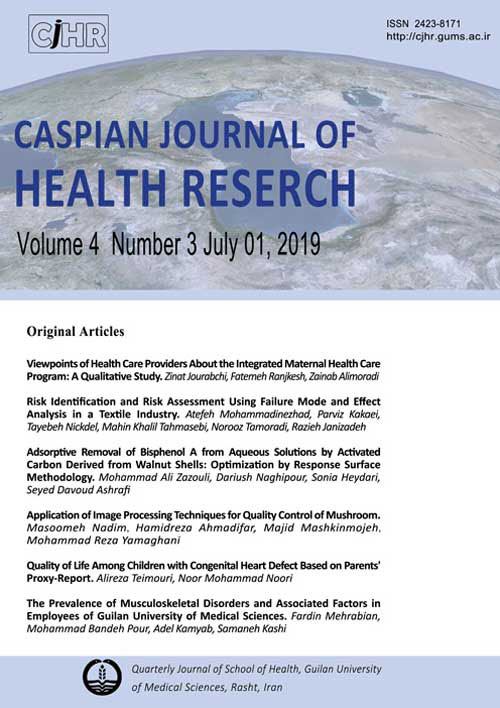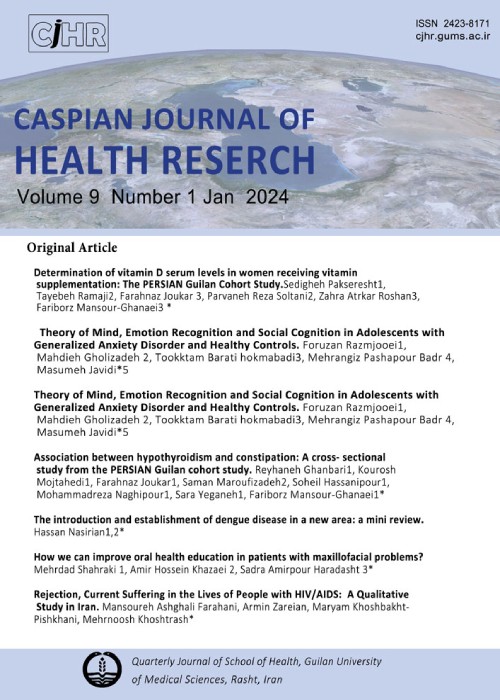فهرست مطالب

Caspian Journal of Health Research
Volume:4 Issue: 4, Dec 2019
- تاریخ انتشار: 1398/07/09
- تعداد عناوین: 5
-
Pages 86-89Background
Insulin serves an important role in brain metabolism, and insulin resistance and subsequent diabetes mellitus type 2 (DM2) can give rise to dysfunction of brain metabolism. This study aimed to test the hypothesis of association of late onset Alzheimer's disease (AD) with DM2 in an Iranian population.
MethodsIn this case-control study, 243 subjects including 81 patients with late onset AD and 162 healthy controls were recruited. The frequency of DM were compared in AD patients with non-AD counterparts.
ResultsThe prevalence of diabetes in AD and control patients was 27% and 9%, respectively. (OR = 3.94, 95% confidence interval: 1.89-8.22). After adjustment for age and gender, there was a significant association between DM2 and AD (OR = 3.7, 95% confidence interval: 1.73-8.00).
ConclusionThe evidence from the present study suggested that DM2 was associated with AD in an Iranian population. Further longitudinal studies are warranted to confirm this finding.
Keywords: Alzheimer's disease, Brain metabolism, Diabetes mellitus type 2, Insulin resistance -
Pages 90-93Background
Topical anesthesia (TA) may accompany with more discomfort for some patients during cataract surgery. We aimed to evaluate the potential factors that can be used for predicting patient’s cooperation during phacoemulsification surgery under TA.
MethodsOne hundred sixty consecutive cases that were candidate for phacoemulsification surgery enrolled in this prospective study. Patient characteristics including sex, age, place of residence (urban or rural), education level (literate and illiterate) and physical examination variables including visual acuity in logarithm of minimum angle of resolution (LogMAR), reaction to eye drop, and cooperation during tonometry before surgery were evaluated. Patient cooperation during surgery was classified into successful (good and satisfactory) or failed (weak) cooperation. The two groups were compared in terms of baseline and clinical examination variables.
ResultsIn this study, 103(64.4%) cases showed a good or satisfactory cooperation, and others had a weak cooperation. There was no association between patient cooperation during surgery and sex (P-value = 0.2), age (P-value = 0.7), place of residence (P-value = 0.3) and education level (P-value = 0.3). The successful group showed a higher rate of non-reaction to eye drop (P-value = 0.0001), good cooperation during tonometry (P-value = 0.0001), non-reaction to press on lacrimal sac (P-value = 0.0001), and lower visual acuity (P-value = 0.045). In the multivariate logistic regression model, non-reaction to eye drop (OR = 66.4), good and satisfactory cooperation during tonometry (OR = 21.2, OR = 7.2, respectively) compared to weak cooperation, lower LogMAR of visual acuity (OR = 7) were significantly associated with the success of TA.
ConclusionThis study showed that some ocular examination tests before surgery including visual acuity, reaction to eye drop, cooperation during tonometry and reaction to press on the lacrimal sac can predict patient cooperation during phacoemulsification surgery under TA.
Keywords: Cataract, Phacoemulsification, Patient cooperation, Topical Anesthesia -
Pages 94-98Background
Today, the hospital's priority is to attract and retain customers. Recent research has shown that the provided quality of services can influence customer reuse, loyalty, trust and satisfaction. The purpose of this study was to investigate the relationship between service quality and loyalty, trust and satisfaction of patients in health and medical centers of Gilan University of Medical Sciences through structural equation modeling.
MethodsThe present study was conducted on 384 people referred to Gilan University of Medical Sciences. Service quality was assessed using a questionnaire on 5 dimensions of infrastructure, space, object, interaction and process quality. The validity of the research instrument was assessed by factor analysis and its reliability was estimated by Cronbach's alpha coefficient. The conceptual model of research was tested through structural equation technique in SmartPLS software.
ResultsInfrastructure (r = 0.51), object (r = 0.2), atmosphere (r = 0.11), interaction (r = 0.09), and process quality (r = 0.14) had direct and significant impact on satisfaction. Satisfaction as a mediator variable was also positively influenced trust (r = and loyalty.
ConclusionThe results of this study revealed that Infrastructure quality followed by object quality had greatest impact on satisfaction.
Keywords: Quality of service, Loyalty, Trust, Satisfaction -
Pages 99-104Background
Dyes are one of the most important pollutants found in the sewage of many industries, including; textile, printing, wood and paper industries, tanning, cosmetics and are often toxic, carcinogenic, mutagenic and non-biodegradable.This study aimed to investigate the removal of Basic Blue41 (BB41) by the oxidation process by using laccase in presence of ABTS mediator.
MethodsThe present study is an experimental in vitro study that investigated the main and interaction effects of three variables of pH, mediator concentration and laccase activity in three levels on BB41 removal efficiency by Response Surface Methodology (RSM), based on Box-Behnken design.
ResultsAccording to the results of the dye removal experiments, in the solution pH of
5, 0.2 mM of ABTS and the 0.2 U mL−1 of laccase, BB41 was not observed in the tested sample solution and the final solution was completely colorless. Also, the statistical analysis of the data obtained from the experiments and the results of the analysis of variance showed that the model was statistically significant (P-value < 0.0001) and could reliably predict BB41 removal efficiency by laccase enzyme.ConclusionThis study found that laccase enzyme can be used to remove BB41 dye from aqueous solutions under optimum conditions designed by RSM.
Keywords: Enzyme, Laccase, Dye, Basic Blue 41, Response Surface Methodology -
Pages 105-109Background
Sexual satisfaction was one of the primary issues in marital life, but there are always factors that affect this satisfaction and affect the personal and social well-being of families. This study was aimed to investigate factors that may decrease couples' sexual satisfaction through a qualitative research.
MethodsThis study was a qualitative content analysis research. Purposeful sampling was used and after in-depth and open-ended interviews with 12 couples (12 female and 12 male), their experiences were analyzed through a thematic method.
ResultsFindings revealed that the reasons of sexual satisfaction reductions include personal deficits (cognitive distortions and inattention), interpersonal conflicts (interpersonal interference, weak interpersonal communication skills), and socioeconomic challenges (Fear of being labeled, economic shortages, and lack of skilled interveners).
ConclusionThis qualitative research clarified some socio-cultural factors contributing to sexual satisfaction. The findings may have implication in the area of programming and planning for family health.
Keywords: Interpersonal Conflicts, Sexual satisfaction, Socio-Economic Challenges


